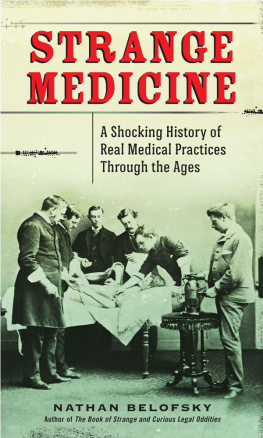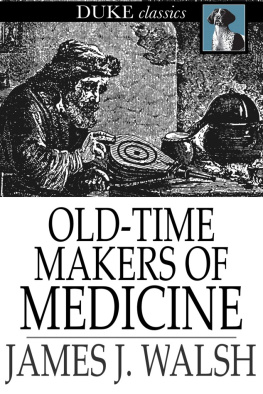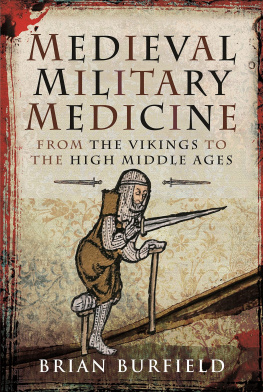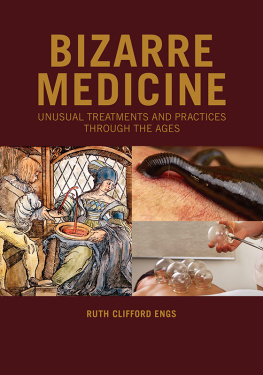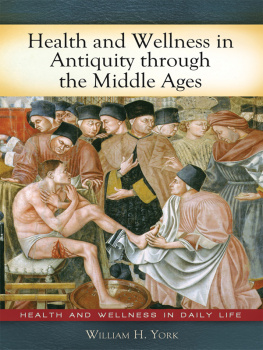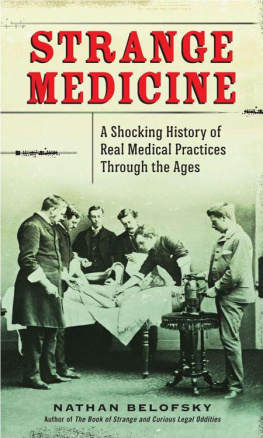STRANGE MEDICINE
STRANGE
MEDICINE
A Shocking History of
Real Medical Practices Through the Ages

Nathan Belofsky
A PERIGEE BOOK
A PERIGEE BOOK
Published by the Penguin Group
Penguin Group (USA) Inc.
375 Hudson Street, New York, New York 10014, USA

USA | Canada | UK | Ireland | Australia | New Zealand | India | South Africa | China
Penguin Books Ltd., Registered Offices: 80 Strand, London WC2R 0RL, England
For more information about the Penguin Group, visit penguin.com.
Copyright 2013 by Nathan Belofsky
All rights reserved. No part of this book may be reproduced, scanned, or distributed in any
printed or electronic form without permission. Please do not participate in or encourage piracy
of copyrighted materials in violation of the authors rights. Purchase only authorized editions.
PERIGEE is a registered trademark of Penguin Group (USA) Inc.
The P design is a trademark belonging to Penguin Group (USA) Inc.
Library of Congress Cataloging-in-Publication Data
Belofsky, Nathan.
Strange medicine : a shocking history of real medical practices through the ages/
Nathan Belofsky.
pages cm
A Perigee Book.
Includes bibliographical references and index.
ISBN: 978-1-101-62458-6
1. MedicineHistory. 2. Traditional medicineHistory. I. Title.
R133.B33 2013
910.9dc23 2013007162
First edition: July 2013
Text design by Kristin del Rosario
While the author has made every effort to provide accurate telephone numbers, Internet
addresses, and other contact information at the time of publication, neither the publisher nor
the author assumes any responsibility for errors, or for changes that occur after publication.
Further, the publisher does not have any control over and does not assume any
responsibility for author or third-party websites or their content.
Most Perigee books are available at special quantity discounts for bulk purchases for sales
promotions, premiums, fund-raising, or educational use. Special books, or book excerpts, can
also be created to fit specific needs. For details, write: Special.Markets@us.penguingroup.com.

Introduction

F ROM the ancient Greeks until the time of Lincoln, medicine did more harm than good, and hurt more than helped. Historian David Wootton has written, For 2,400 years patients have believed that doctors were doing good; for 2,300 years they were wrong.
Greek doctors of two thousand years ago were at least as effective as, and probably did less harm than, the physician/astrologers of the Middle Ages, or the pompous windbags of the Renaissance, or the medical wrecking balls of medicines Heroic Age. Only in the twentieth century did medicine regain its stride, too late for most.
Hippocrates would have been appalled.
With due apology to historians and scholars, many of medicines strangest ideas and dumbest procedures remain hidden from view, buried in the library stacks. This book attempts to correct this oversight and, along the way, introduces an honor roll of doctors, scientists, and medical thinkers who, however inadvertently, sent medical thought and practice hurtling backward.
This is not historyfar from itbut the facts revealed here are true, as best we know. The book focuses on widely accepted ideas and practices by real doctors, not quirks or quacks, and virtually all the doctors mentioned were among the leading medical figures of their time. So, in the Middle Ages, John of Gaddesden, doctor of medicine at Oxford, really did hang cuckoos heads from the necks of epileptic patients, and later Dr. Benjamin Rush, signer of the Declaration of Independence and treasurer of the Mint, spun his mentally ill patients like tops. Later still, Dr. Walter Freeman of Yale, the worlds best-known brain surgeon, would drive ice picks into his patients eyes with a carpenters mallet.
Chapter One briefly surveys ancient medicine, a time of trial and error, and great ingenuity as well. Chapters Two and Three explore the medicine of the Middle Ages and the Renaissance, when leading doctors and professors dreamed up some of the most bizarre medical ideas known to humankind and then proceeded to inflict them on their patients. Chapter Four explores medicines reckless Heroic Age, not so long ago, when doctors went after diseases and their patients with near-comic ferocity, and predictable results.
CHAPTER ONE
Growing Pains

W HAT we think of as real medicineWestern medicine at leastbegins with the Greeks and wise old Hippocrates, who was born on the Greek island of Kos around 460 BC. His writings and those of his followers are preserved in The Hippocratic Corpus, a collection of about sixty medical works.
Although most healers looked to the gods to make patients better, Hippocrates relied on the evidence of his own eyes and ears, and the touch of his hands. Above all, Hippocrates did what worked, regardless of theory or belief, and thus managed to turn the corner from magic to medicine.
Sometimes even the great Hippocrates got things wrong, big-time. Most critically, Hippocrates believed that illness was caused by an imbalance of the four humors (blood, black bile, yellow bile, and phlegm), a theory that would come to plague doctors and their patients until the nineteenth century.
Still, medical thought and practice flourished, with a few detours along the way. A few hundred years after Hippocrates came Galen, the great Greek anatomist living in Rome. He was forbidden by law to dissect human bodies, but his work with animals, mostly pigs, showed for the first time, from the inside, how living things actually worked.
What follows is a brief description of a few ancient medical practices and ideas, before and after Hippocrates. Some worked, some didnt, but all provide a good jumping-off point for the even stranger things to come.
The Power of Babel
[T]hey lay him in the public square, and the passersby come up to him, and if they have ever had his disease themselvesthey give him advice, recommending him to do whatever they found good in their own case, or in the case known to them. And no one is allowed to pass the sick man in silence without asking him what his ailment is.
GREEK HISTORIAN HERODOTUS, WRITING OF BABYLONIAN MEDICINE
In ancient Babylonia, sick people either got better or died, with little help from their medicine or their magic.
From clay tablets fortuitously baked to stone during a fire, we know that Babylonian shamans, the asipu, and physicians, the asu, often worked together, though the asipu seem to have received the most attention.
Believing that some illnesses came from troublemaking gods and demons and others from a persons own bad behavior, the asipu determined why a person had become sick and prescribed a course of treatment. For guidance, an asipu might look for omens on the way to an ailing patients housesay, the lifting of a pigs tail.

